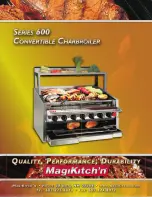
20
fig. 19
GW 411/1
fig. 20
GW 333/0
fig. 21
GW 334/0
fig. 22
GW 335/0
Note:
If it is necessary to install any conden-
sate pipework externally, then it
should be kept as short as possible,
be insulated with waterproof insu-
lation and have a continuous fall of at
least 2.5 ° (i.e. 45mm fall for every
metre length).
Refer to the British Gas publication
`Guidance notes for the installation of
domestic condensing boilers' for
further information.
Before operating the boiler the con-
densate trap on the boiler (1, fig. 19)
must be filled with water as described
in Section 5.6 `Filling condensate
trap'.
4.7 Connecting the flue
assembly to the boiler
(Note: Refer to the air/flue duct instal-
lation instructions for full details of
installation of the air flue duct. This
Section is included for further refer-
ence only, e.g. in case the boiler has
to be removed from the wall.)
4.7.1 Horizontal Flue
Place a 95 mm diameter x 88 mm
long air duct clamp (1, fig. 20) over
the air duct.
Push the sliding sleeve (1, fig. 21)
over the cut end of the flue duct.
Fit the flue elbow to the boiler by
inserting the spigot of the flue elbow
into the flue outlet socket of the boiler.
When correctly fitted the air duct of
the flue elbow should butt up to the
boiler air duct.
Line up the flue elbow socket with the
air/flue duct and pull back the sliding
sleeve so that it engages into the
socket of the flue elbow (fig. 22). The
sliding sleeve must penetrate the flue
elbow socket such that there is at least
20 mm engagement at both ends of
the sliding sleeve (fig. 23)
















































